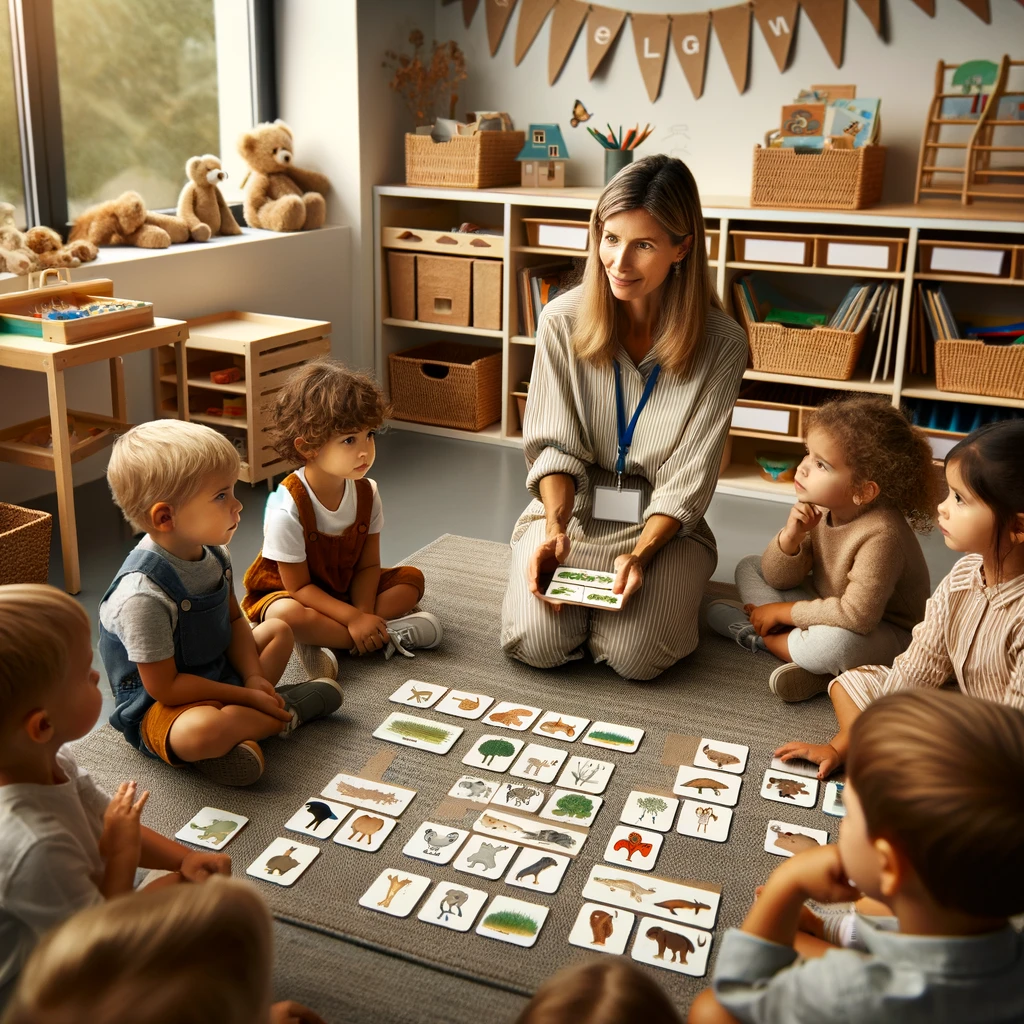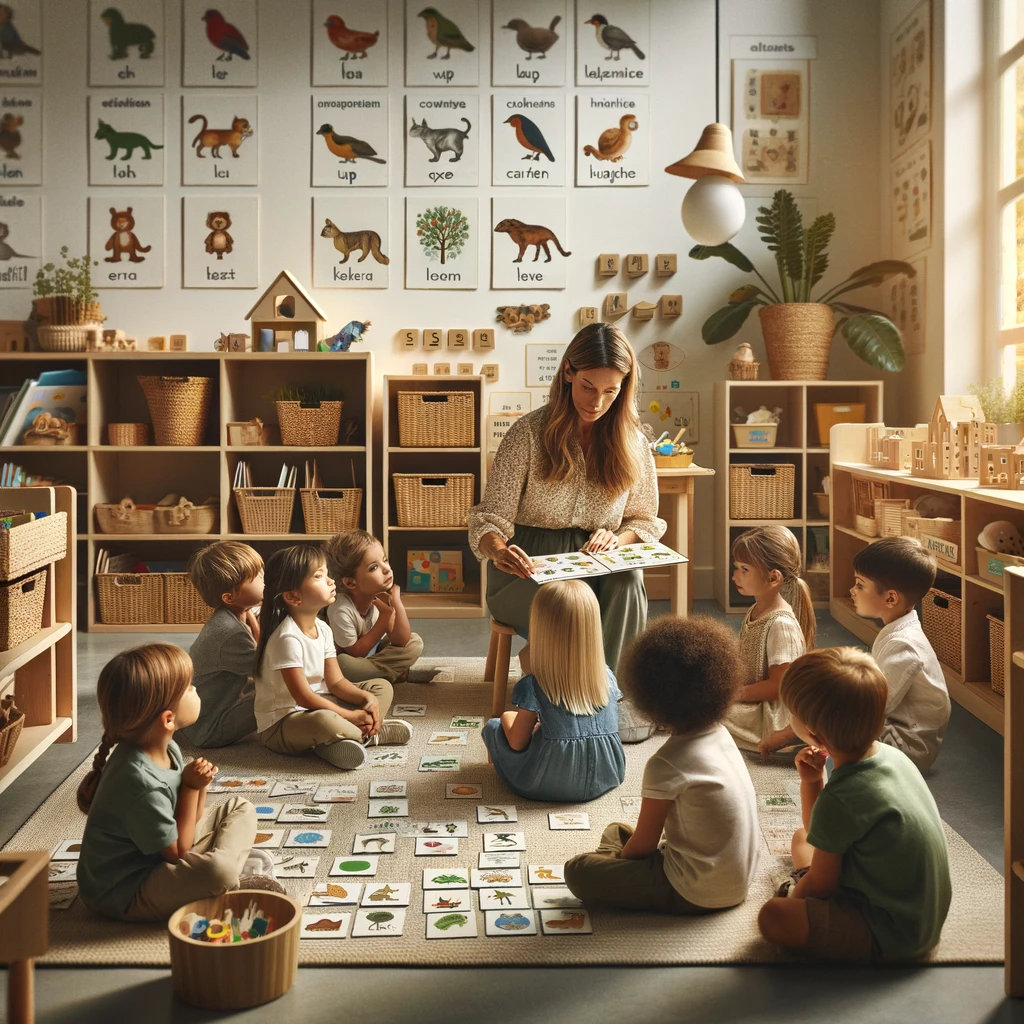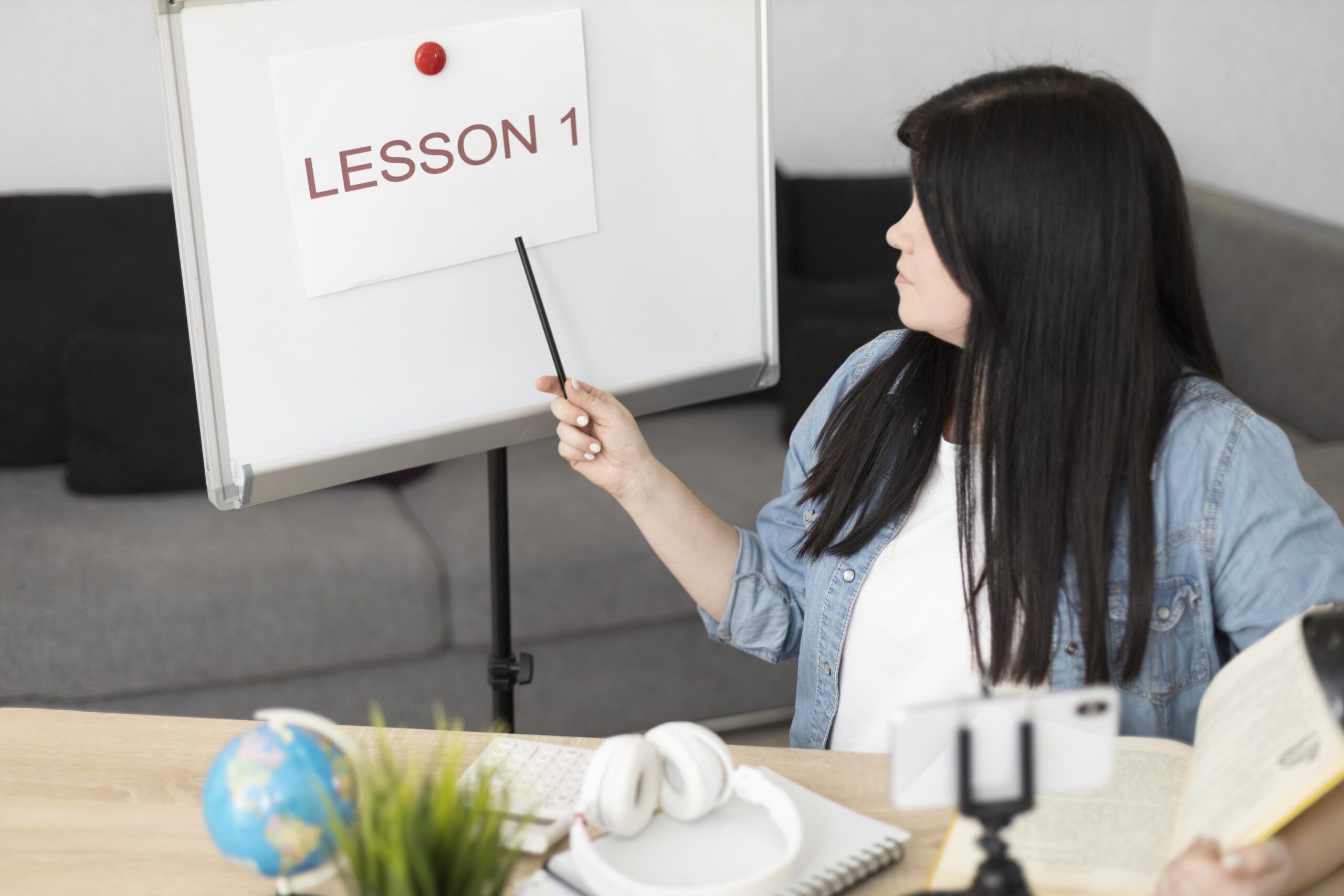Montessori language activities for preschoolers “Language development …I say development , not teaching , for the mother does not teach her child language .It develops naturally, like a spontaneous creation.”
Most of the children already have command over spoken language at the time of entering a Montessori school . At about three years of age the child can consciously begin to explore language. Previously, he has been constructing language skill unconsciously , but now is time to consciously consolidate all the previous and upcoming language knowledge consciously . This is the perfect time for the child to equip himself with all the necessary language tools.
To teach the child correct oral language , Montessori divided the learning experience into two groups.
The Enrichment of Vocabulary:
;In these activities , the children learn new words on a daily basis through formal lessons and classified group activities.
Language Training :
In this time exercise , the child undergoes a great variety of language experiences .He is exposed to many forms of literature, exercises of self-expression, and games to learn grammar of a language.
Both of these groups of exercises facilitate the child’s later learning in reading as he builds a good stock of vocabulary and gets familiarity with grammatical rules. The purposes in Montessori’s oral Language lessons are vast . Children achieve;
- clarity of speech
- a large expansion of vocabulary
- a familiarity on various aspects of language.
- a level of appreciation and enjoyment of language .
- indirect preparation for the written language work, for reading and creative writing.
In the oral Language lessons. We use a variety of resources to maximize learning and make it a fun-filled experience. The resources include;
- material from the classroom
- classified cards
- different pieces of literature
- and the directors herself
The directress plays the key role in Oral Exercise . It is important for her to remember to do these on a daily basis with every child in the class.
Enrichment or vocabulary
Language lessons must be Montessori language activities for preschoolers given to child right from the first day he enters the classroom .This serves purposes;
- Children gain vocabulary.
- New children get oriented to the environment quickly due to the familiarity of order children with the names of the objects in the environment .
How to proceed ; Begin with broad classifications, such as animals and then move on to sub-classification such as dogs. Following the basic Montessori rule, “Simple To complex” uses three period lessons while presenting new words formally . Devise various types of activities, including ;
- Show Me requiring the child to show you the object .
- Get up and Go requires the child to move around.
- Demonstrate Activities requiring the child to demonstrate doing something for you.
It is important to include vocabulary that the child already knows, in the activities. Also remember not to give too many words to new children in vocabulary enrichment exercises. 
Exercise Montessori language activities for preschoolers
Objects of the Environment
Materials
The objects of the environment such as chair, table, shelf, sink, rug, floor ,etc.
Presentation
Choose three words broadly representing a category e,g.
- floor, wall , and ceiling.
- table, chair, shelf
- bowl, spoon, tray
- jug, scissors, bin
- soap, dish, brush, sponge
- Invite a small group of children to work with you.
- Sit on the floor comfortably at a quiet place in the classroom.
First Period:
- Begin Three period Lesson by naming one of the things. For example , say, as you touch the floor,
“This is the floor.” - Repeat for a few times and have the children repeat with you. Also encourage the children to touch the floor.
- Then, stand u[ and go over to the wall. Touch the wall and say, “This is the well,” Repeat for a few times and have the children touch the wall.
- Go back and sit down with the children.
- Then, point to the ceiling and say, “That is the ceiling ,”repeat for a few times and have the children repeat with you. Also encourage the children to point to the ceiling.
- Repeat the names for each of the things.
Second period:
9.Then, ask one child at a time to show you the floor , the wall or the ceiling.
- You can ask the child to get up to touch the wall or point to the ceiling with both hands or rub the floor with their hand.
- Repeat until the children are comfortable with these three words.
Third period:
- Ask each child to name the different things. While touching the floor or pointing to the ceiling or the wall say , “What is this /that ?”
- Once they all are comfortably naming the object under discussion, dismiss one child at a time by having them tell you what specific form of work they will go off to do

The Sensorial Materials
Presentation
Use three Period Lessons Montessori language activities for preschoolers to introduce nouns and adjectives (Positive , comparatives and superlatives) related to each sensorial material . Please refer to module 3 (Exercises of sensorial Development) for complete lessons.
Note: The child is given the language lesson in sensorial material after he has mastered the use of a material, and is at a point where he has lost some interest in the material.
Exercise 3
Classified Cards
Material: A set of labeled or unlabeled picture cards representing a class of things, e. G. Animals, plants, kitchen tools, cleaning Tools, furniture, etc.
Note : Begin with broad classifications, such as animals and then move on to sub-classifications such as mammals.
Presentation 1 (Three Period Lesson )
(Note ; Full work cycle to be observed )
- Choose one set of cards and invite one child (or a small group of children ) to work with you preferably on a table.
- Introduce the cards conversationally/non-formally.
- Show the child the classification card, and discuss what he sees on the card e.g. a kitchen.
- Place this card face down next to the box of cards.
- Go through all of the cards separate the cards he knows and the sards he does not know.
- Teach the child the name of the cards he does not know by doing a Three Period Lesson with three cards at a time.
- When the child is sure of all of the names, mix the cards he knows .
- Lay out the cards on the table in a column from top bottom and say the names as you do so .
- Mix them again and invite the child to lay them out, and ask him to say the names of the objects on the cards as he does so.
- Do a second three Period Lesson with the entire set.
- Put the entire set back into the box.
- Tell the child that he can now work with the set whenever he likes.
- This exercise is repeated with other sets of cards, and the child can later work with any set of cards he has been shown.
Presentation 2 (sorting cards)
(Note: full work cycle is to be observed )
- choose two sets of classified cards that the child is already well familiar with e.g. transport and living room cards.
- Tale out the classification card from each set e. g. one card from the set of transport means and one from the of living room. (We will refer to these two cards as matching cards.)
- Mix the remaining cards in both the sets together in one pile.
- Place the matching cards ( that you look out before mixing both the sets) next to each other, with some reasonable space between them towards the top of the table.
- Ask the child to pick up one card at a time from the pile, say its name and place it in a column under its appropriate matching card.
- Once the child is comfortable using two sets, he can be shown how to use three or four different sets in the same way.
Exercise 4: Nomenclature Cards
Materials
- Collections of unlabeled classified picture cards illustrating terms, as those used in a particular science or art such as geography, particular science or art such as geography, geometry, biology, etc.
- Have about 200 sets of cards that you will change regularly and frequently whenever needed.
Exercise 4 :Social Vocabulary
This kind of vocabulary Montessori language activities for preschoolers is given through role play as in Grace and Courtesy lesson in Module 2 Exercise of Practical Life (EPL). Words and phrases like thank you, excuse me, please, forgive me, good morning, good afternoon, good evening, good day, good bye, see you, etc. are introduced and their use is role played.
Material
In some exercises objects present in the environment can be used
Presentation :
- Invite a group of children.
- Demonstrate the term being taught and act it out yourself first.
- Invite the children to repeat that little drama .
The purposes of all the above (Vocabulary enrichment ) exercises include;
- . enrichment of child’s vocabulary .
- Enhancements of child’s observation.
- Understanding of classification of the environment.
- Preparation for other cultural studies
Exercise 1
Telling Reading Stories
Make the children sit in Montessori language activities for preschoolers a semi-circle for the clarity of view, if you are reading/telling the story to more than one child. This is important to keep the interest of the children alive , and make your gestures and facial expressions visible, which help children understand the story better.
When it comes to the selection of stories, make sure that they are about reality, whether true or fictional. You may select fantasy stories also but tell/read them to older children who have already established a sense or reality.
Telling /reading a story, don’t show the images or pictures too often to the child, so that the child can make his own images in his mind. Also give credit to the author and the illustrator.
Encourage children to sometimes share their own stories, or the stories they have heard from you. Once the story has been read to the children , it can go to the Book Corner where the children can look at it whenever they like.
Exercise 2
Poetry -Rhymes, Jingles and Songs
Poetry is a beautiful way of expression that naturally attracts the child. Extreme care should be taken while selecting poems for children. Any poem/rhyme employing any kind of violence, negativity, racism, taunting or abusive expressions should not be included.

As a guideline, do one poem a week, beginning with short poems that can easily memorized . The directress should first read out the entire poem aloud to give the children an overall idea of the entire poem .Then the directress repeats the first line of the poem and has the children repeat after her. This should continue in this way until the children have learned the entire poem. Singing poems make memorization much easier and also enable children to enjoy the rhyming patterns and other poetic element in a poem. Singing should be done regularly in the classroom.
Exercise 3
News Time
This can be any time of the day. Giving news can be done with one child, in small groups, or even with the whole class. It is important to keep News spontaneous and not a daily activity. Doing it daily at a specific time would make it an artificial and formal activity for the child, which discards the real spirit and spontaneity of sharing.
By sharing news Montessori language activities for preschoolers we develop the child’s confidence and provide him practice in self-expression . Sharing news is a brilliant way to express oneself, and it is an important moment for the child .The directress should listen to the child with interest when he is sharing news, whether the news is being or small without postponing .Later on, the directress can ask the child to share the same news with the whole class during the news time if he so wishes.
The directress can encourage sharing of news during the news time by sharing news herself. This should be more frequent during the beginning of the year. As it serves as a guide for the younger children .
The director can pose intelligent questions to introverted and shy children, requiring more description of the news they want to share. Open questioning by students should also be encouraged. The older children act as a guide and inspiration for the younger children in sharing news.
A good director is always aware of the problems children face and is all set to help them e.g. some children may need help in stopping , some may need help speaking more slowly and some may need help speaking in an audible voice.
Exercise 4
Books corner
The library corner consists of low bookshelves containing a Montessori language activities for preschoolers good collection of books , a floor mat, two small chairs, a table lamp.
The books corner is a small library within the classroom where the child can go to read or just to look at the pictures in a book.
All the constituent elements of a book corner serve a specific purpose. the floor mat adds a homely look, while the lamplight sheds a soft but direct light onto the books being read. As the book corner should be a peaceful area, we restrict the number of chair to two only so that the environment remains suitable for reading.
The shelves should have four horizontal shelves with ledges at different heights. We arrange the books with the least amount of text and maximum pictures and illustration on the bottom ledge, so that younger children who are not yet proficient at reading can take those books easily. The amount of text at each succeeding level on the shelf increases as we go higher.
The books should be of good quality with realistic content, covering a wide range of topics. The paper should be of good quality and paperback copies of book should be laminated for durability . Any damaged book should be fixed with the help of children . Irreparable books should be removed from the classroom.
Exercise 5
Asking Questions game
Asking to young children is especially Montessori language activities for preschoolers important as it makes them think . A series of related questions can make the child think more than he would naturally do, thus doing a great exercise of mind.
This game can be played in a group or with an individual child . For example, if a child had an egg in the lunch, you may ask;
- Where do eggs come from ?
- How many parts are there on an egg ?
- In how many ways can we prepare an egg to eat ?
- Are there other animals also ( apart from chicken ) which lay eggs ?
- Why do animals lay eggs ?
- What color normally are the chicks ? etc.
Converse regularly with children, and encourage sharing of ideas. Some children may take longer than usual to answer your question .. be patient and wait for the reply.
Exercise 6
Grammar Games
Grammar games are played to informally introduce parts of speech like verbs, nouns, and articles, etc. . and teach their proper use to the child. Please refer to Module 5 (grammar Activities Section) for a detailed so these games.

My partner and I absolutely love your blog and fiund thhe majority of
your post’s to be eactly I’m looking for. Would you offer guest
writers to write content for yourself? I wouldn’t mind composing a post or elaborating on many of the subjects you write regarding here.
Again, awesome site! https://WWW.Waste-Ndc.pro/community/profile/tressa79906983/